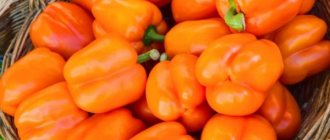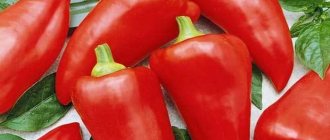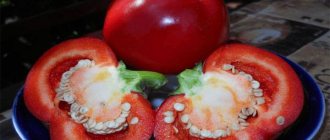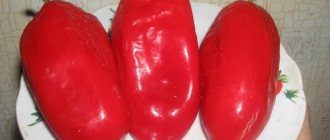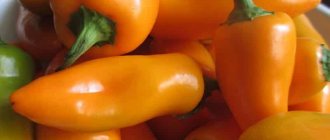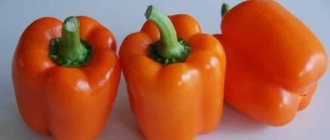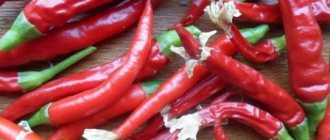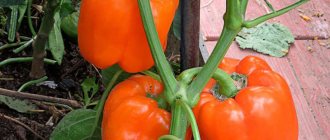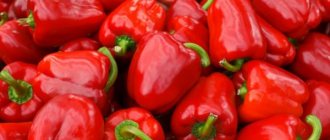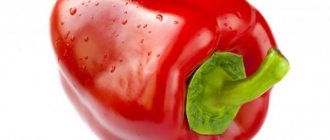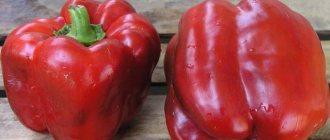Thanks to the developments of modern breeders, farmers from regions with cool climates have the opportunity to successfully grow sweet peppers. For example, Merchant was designed specifically for areas with adverse weather conditions. In addition to cold resistance, this variety has many other advantages. This material, along with an external description of the vegetable, will present its pros, cons, as well as cultivation rules.
Pepper Kupets, description and photo
The Kupets pepper variety was developed by breeders at the West Siberian Laboratory in 2001. Their goal was to breed a species that would be adapted to growing in cold regions.
The result is a variety that is suitable for planting in any region; it is actively planted in Ukraine and the Russian Federation.
Description of culture:
- The variety is early ripening.
- The bush is spreading, its height is eighty to ninety centimeters.
- The stem is dense, has a powerful root system, and therefore does not require garter.
- The fruits are green when unripe and turn red when ripe. The pulp is juicy and tasty, the product contains many vitamins.
- They are actively used for preparing soups, borscht, salads, appetizers, for canning and stuffing.
Comparison with similar varieties
There are many early combs of bell peppers, the features of which are worth familiarizing yourself with in order to decide on your favorite:
- Big Mama is a pepper variety with large orange fruits that have a rectangular shape. In a greenhouse, the crop grows up to 100 cm in height; if the soil is not cleared, then no more than 55-70 cm. Peppers retain excellent taste even after heat treatment.
- Swallow is a pepper variety whose growing season lasts 110-130 days. This species bears fruit for a long time.
- Atlas - brings a great harvest. The fruits of the crop are larger than many others (0.4 kg each), have a sweet taste and a rich red hue, their walls are about 1 cm thick. The fruits reach a length of up to 20 cm.
In general, sweet pepper Kupets adapts perfectly to the different climatic conditions of the region in which it is planted. The culture has many positive qualities due to which this species is in demand.
Characteristics of the sweet pepper variety, pros and cons
Characteristic:
- The growing season lasts from one hundred ten to one hundred twelve days.
- The weight of the fruit is about one hundred grams, the thickness is five to eight millimeters, the shape of the pepper is pyramidal.
- The temperature for growing during the day is twenty-six, twenty-eight degrees, and at night plus fifteen to eighteen degrees.
- This variety, unlike others, is able to withstand temperatures down to + 8 C.
- Designed for cultivation both in greenhouses and in open areas.
- The vegetable is stored for a long time and tolerates transportation well over long distances.
Positive traits:
- self-pollination possible;
- high fruiting;
- long-term storage.
Flaws:
- possible infection with fungal diseases, susceptible to attacks by many insects;
- the bushes are branched, so when planting it is worth allocating enough space;
- With prolonged cold weather, the thickness of the walls of the fetus suffers.
Let's watch a useful video about growing merchant pepper:
Disease resistance of the variety
This variety has not proven itself well as having good immunity to various fungal diseases. Therefore, it should be regularly inspected for signs of various deviations from the growth norm and to identify the appearance of harmful insects.
To prevent diseases, it is worth maintaining the planting scheme and treating the plants using traditional methods. If the owner notices that the bush is infected, it should be carefully removed from the bed with a lump of earth. Then destroy outside the site to avoid contamination of the soil in the garden.
Merchant is a worthy competitor to other crop varieties on the market
Productivity, fruiting time
The yield of the variety is three kilograms per square meter, regardless of whether the outside temperature is cloudy, hot or cold.
Sometimes, with ideal care, the yield exceeds five and a half kilograms.
The fruiting period is 112 days. If the summer is very cold, the period can last up to 120 days.
Peppers for the Urals - making the right choice
Pepper in the Urals is cultivated in open ground, closed ground, and also in unheated greenhouses. Experienced summer residents begin to plant seedlings towards the end of May, when the danger of return frosts has passed and the temperature outside will be stable in order to plant young seedlings in the garden. Despite the harsh and unstable conditions, gardeners every year prefer to plant the best varieties of peppers for the Urals:
Winnie the Pooh is an early ripening variety, ripens in 110 days. The bushes are compact in shape, low (0.30-0.35 m). The harvest ripens almost simultaneously;
Winnie the Pooh pepper variety – pictured
pepper variety Winnie the Pooh – pictured
Pioneer - recommended for cultivation in cold zones, ripens in 116-136 days. The height of the bushes is 0.6-0.7 m, the fruits are cone-type, weighing 50-55 g, yield 0.8-0.9 kg/m2;
Pioneer pepper variety - pictured
Bogatyr is a representative of mid-season varieties, grows well, is not too demanding of light, develops and bears fruit at low temperatures. Easy to care for, produces juicy, tasty red fruits. The weight of one fruit is 75-100 grams, the yield is 2.3-4.1 kg/m2;
Merchant is an early ripening pepper (109-111 days) with thick walls (7-8 mm). The weight of one fruit is 245-250 g. The plants are tall (1.0-1.2 m). The taste is excellent, the yield is 7-16 kg/m2;
pepper variety merchant – in the photo
Yellow and Red Bull are early varieties (95-108 days), differing only in color. The fruits are large, slightly ribbed (0.2 kg). Plants are tall and productive, 14-20 kg/m2;
Dobrynya Nikitich - early ripening pepper (90-92 days). Bushes of standard form, medium branching. Vegetables are large in size (120-125 grams), rich red in color and have strong thick walls (8-9 mm), excellent in taste;
Atlant is a good pepper, mid-season, can be grown under film covers and on open plantations. The variety is tall and branched. The fruits are large (190-200 g) with a wall thickness of about 5 mm, pleasant taste;
Atlant pepper variety – in the photo
Atlant pepper variety – pictured
Atlant pepper variety - pictured
Triton is a sweet pepper, early ripening, productive. It is characterized by increased resistance to adverse weather. The fruits are medium-sized, weigh 100-150 grams, cone-shaped, red when ripe;
Chrysolite is an early bell pepper. The plants are standard, the foliage is average, the yield is good (12.2-12.6 kg/m2) and stable. The peppers are large, weighing 0.14-0.16 kg, walls of average thickness 4-5 mm, weak ribbing.
Sweet pepper varieties for growing in Siberia
In the conditions of Siberia, with its sharply continental climate, it is recommended to grow hybrid varieties bred specifically for these conditions. It is preferable to choose bell peppers with early or mid-early fruit ripening.
Higher yields can be obtained from peppers grown in protected soil or using covering materials.
An early-ripening and high-yielding variety bred in Western Siberia.
Peculiarities:
- bushes with a compact crown, low - up to 50 cm;
- fruits are barrel-shaped, weighing up to 170-200 g, with a wall thickness of 6-8 mm;
- The color of peppers when ripe is light green, when fully ripe - yellow.
Grown seedlings are planted in the ground at the age of 60-70 days. The recommended arrangement of bushes is up to 5-6 plants per 1 square meter. meter.
Moneybags
The variety is mid-season, with good yield indicators. The fruits are large, one of the thickest.
Characteristic features:
- bush with a medium spreading crown and dense foliage, up to 50-60 cm in height;
- the crop begins to ripen approximately 130-150 days after germination;
- the fruits are quite voluminous, weighing up to 160-200 g, walls and thickness up to 8-10 mm;
- peppers are round in shape, with slightly pronounced ribbing; ripe specimens are bright red.
Sowing of seedlings is done in late February or early March. They plant in the beds when the threat of cold weather has passed.
Golden Taurus
A mid-early variety adapted to the Siberian climate. Plants are disease resistant and have good yields.
Variety characteristics:
- bush with a semi-spreading crown, medium size - height 70-75 cm;
- under favorable conditions, the yield is 3-4 kg per 1 sq. meters of plantings; up to 10-15 fruits are formed on one bush;
- the crop ripens in 125-135 days from germination;
- the fruits are very large, weighing 200-250 g (individual specimens - up to 500 g), cuboid in shape; ripening fruits change color from green to yellow-orange;
- The pulp is fleshy, with a glossy skin and a wall thickness of up to 10 mm.
When planting seedlings, it is recommended to place no more than 5 bushes per 1 square meter. meter of area.
Sweet chocolate
A mid-early variety with good yield indicators. Bred in Siberia and adapted for local climatic conditions.
Properties inherent in the variety:
- medium-sized bush, 70-80 cm high;
- the harvest begins to ripen 115-120 days after germination;
- fruits are rounded-prismatic, with a rounded tip, weighing 80-100 g; walls 5-6 mm thick;
- the pulp is juicy, the surface is glossy;
- at the stage of technical ripeness, the fruits are dark green, ripe peppers are chocolate-colored, the inside of ripe peppers has a reddish tint.
Among the distinctive features of the variety are the unusual pleasant taste of the fruit and a chocolate aroma with a slight bitterness.
The video shows the features of the variety - Sweet Chocolate. Filmed by the All varieties channel.
Low growing varieties
When choosing the best varieties of tomatoes for open ground from low-growing ones, you should understand that a small plant 40-50 cm high cannot produce the same marketable yield as a vegetative form of 2 meters.
Among the most productive, the following are worthy of attention:
"Admiralteysky"
Early ripening salad tomato. It tends to lay the first bunch above 5-6 leaves. The shape of the fruit is flat-round, the fruit itself is dense, smooth, very fleshy. The stalk has a green, permanent spot. Tomato weight is up to 200 g. The taste is very good, sugar content is up to 3%. Productivity up to 9 kg per m2. The fruits ripen together
"F1 Debut"
Salad, early, flat-round, with slight ribbing. Medium-density red fruits. There are 6-8 nests in a tomato. Weight is within 230-230 g. Tasting rating is good and excellent. Productivity up to 10 kg per meter. The variety is resistant to fusarium.
"Merchant's Wife F1"
The variety produces fruits weighing up to 250 g and requires support and garter, and in some places even shaping.
The plant has a beautiful bush with large foliage of the characteristic tomato type. The fruits are flat-round, medium in density, smooth. The green spot is present even in a ripe state. The ripe fruit is red. Tomato has 4-6 nests. According to taste
Rated "good". Productivity up to 9 kg per square meter. The plant is very resistant to verticillium and fusarium.
"Simona F1"
The flat-round, slightly ribbed fruit will delight you with an amazing taste. A very dense tomato will never allow itself to crack. When fully ripe, the fruit is red with more than 4 nests. Weight varies between 240-280 g. The variety has enviable resistance to fungal wilts.
Read also: Tomato varieties of Siberian selection with photos and descriptions
"Krasnodon F1"
The plant is mid-season, lettuce with round, dense and slightly ribbed fruits. When fully ripe, the fruits are scarlet in color with 4-6 nests and weighing about 240 g. Even a gourmet will like the excellent taste range. The variety is very resistant to tobacco mosaic virus and wilt caused by fungi.
"Sungari F1"
Recommended for cultivation in all regions. Although the plant is powerful, it is very difficult for it to hold a huge harvest of large tomatoes weighing up to 250g, so it requires gartering, shaping and supports. Early fruiting will allow you to enjoy the excellent taste of round, beautiful, smooth fruits with a very dense consistency. The red fruit is completely devoid of a white spot on the stalk. When cut, more than 6 nests are visible. The variety is quite resistant to classic tomato diseases.
"Three Bears F1"
All regions can afford to grow this tomato. Without garters and supports, the branches will break off under the weight of the fruit of 250-260 g. The plant will early delight you with a harvest of round, slightly ribbed, dense salad tomatoes of a rich red color. The tomato has a very large leaf characteristic of the variety. When cut, you can count 6 nests, sometimes more. In terms of taste, this tomato can be considered one of the best.
"Anniversary F1"
Tomato for a sophisticated, early salad. The shape of the tomato is flat-round, it is quite hard and slightly ribbed to the touch. There are from 4 to 6 nests. The weight of the tomato is kept within the range of 180-220 g. The resistance of the variety to a complex of diseases is very high even in unfavorable years, and is never affected by blossom end rot.
Large-fruited
This tomato will absolutely not be able to hold the fruits without a garter. A weight of more than 300 g is normal for the variety. Early and salad, it will forever remain a resident of your garden bed. The fruit has weak ribs on a flat-round “body”. The tomato itself is not very dense, which makes it impossible to transport for a long time. An unripe fruit has a pronounced green spot at the stalk; in a ripe fruit, the spot disappears, and the tomato itself turns red. The tomato has 6 nests and weighs up to 310 g. The tasting committee rated it “good.”
"Ivanhoe F1"
Early, salad variety. If you love pink, large, slightly ribbed tomatoes with great flavor, then this tomato is for you. Reaching a weight of up to 350 g, the fruit becomes flat-round, and the yield of the variety reaches 130 c/ha.
Rules and timing for sowing seeds for seedlings
Sowing dates depend on where the planting will take place. If in a greenhouse, then the seeds are planted at the end of February. If in the beds, then the deadline falls in mid-March.
Recommendations for sowing seeds for seedlings:
- buy high quality seeds, preferably from well-known producers with a good reputation;
- select appropriate flowerpots, be sure to make drainage holes so that excess liquid does not stagnate;
- purchase nutritious soil or make it yourself, using equal proportions of garden soil, sand, peat, turf soil and humus.
- plant seeds in a pot with soil, place them to a depth of no more than one centimeter;
- when the first two leaves are formed, pick into other containers (it is better to use disposable cups or peat tablets, this will allow you not to injure the roots during subsequent replanting);
- carry out hardening before planting in open ground, the procedure is carried out for ten days.
For useful tips on growing lettuce peppers, from sowing seedlings to harvesting, watch the video:
Preparation for cultivation
Seeds are not planted immediately on the beds, otherwise they will not have time to ripen before the onset of cold weather. Soil for seedlings is bought in specialized stores or made independently from ordinary soil, peat or sand, humus (1:1:1) and a handful of ash. Mix the components, kneading the lumps, and calcinate the mixture in the oven for 2 hours at +200 °C for disinfection.
For planting, use containers with drainage holes at the bottom. Sowing begins in February, so that by May the seedlings are ready for planting into the ground.
First, the seeds are sorted, choosing large and dense ones (they will give better germination).
The best way to check planting material is to put it in a glass with a saline solution (10 g of salt per 200 ml of water). The floating seeds are removed, the ones that have sunk to the bottom are used. To protect future plants from fungi and infections, grains are treated with a weak solution of potassium permanganate.
Planting in open ground
The procedure requires the following manipulations:
- Planting begins at the end of May or beginning of June.
- Start preparing the site four weeks before planting the seedlings. Remove debris, grass, and in a couple of days dig up the soil to a depth of forty centimeters.
- Fertilize the soil by adding potassium and superphosphate substances and a little saltpeter.
- Plant the seedlings in moons, the depth of which is fifteen to twenty centimeters. Consider the distance between seedlings, approximately forty centimeters.
If everything is done correctly, inflorescences will very quickly begin to form on the bushes; they must be removed to allow the pepper to take root thoroughly in its new location.
Features of growing and caring for the variety
“Merchant” loves light, loose, fertile soil. Following the rules of crop rotation, you need to choose areas after cabbage, carrots, beans, onions or any greens.
If the seedlings are not in peat pots, then when transplanting them into the soil, you need to put a handful of rotted leaves or peat in each hole.
It is important that watering is carried out only with pre-settled water. If you pour cold water directly from the hose, due to a sharp drop, a disease may begin and the plant will die. It is also recommended to water in the evening. You shouldn't do this too often. It is necessary to maintain soil moisture, prevent drying out, and loosen the soil in a timely manner.
During the entire growing season, several nitrogen fertilizations are carried out. When the ovaries begin to form, additional potassium-phosphorus fertilizers should be added to the soil.
Advice! Do not be happy if 10-15 days after transplanting the seedlings it begins to bloom. The buds must be removed. At this time, the pepper is not yet ready to bear fruit. First it needs to take root well.
Ideal growing conditions
There are some nuances:
- When a sprout appears from the seed, the flowerpots should be moved to light; this will prevent the seedlings from stretching.
- Every day from six in the evening to six or seven in the morning, the seedlings are covered with film.
- During cultivation, maintain the optimal temperature: plus twenty-five degrees, and when the seedlings germinate and the time comes to strengthen the roots, reduce the temperature to plus thirteen.
- Water moderately, use only warm water and water only at the roots.
- Add fertilizer for growth. Do this three times. The first time is when several leaves form, and the remaining two every ten days.
The tips are simple, but very important!
Care instructions
In the future, the crop needs watering, fertilizers, weeding and bush formation.
Watering is carried out once every seven days, the water temperature is plus twenty-five degrees. In dry weather, watering is allowed up to three times a week. The main thing is to prevent water from getting on the leaves.
Fertilizing during cultivation is enough for thirty days, so after rooting the bushes, nitrogenous substances, potassium and phosphorus are introduced.
Loosening the soil improves its oxygen saturation, which promotes growth.
Shaping the plant will be done several times during growth. The first procedure includes pinching the top shoots, the top should not exceed 35 centimeters, and the crown flowers are cut off.
Then, when the stems fork, the excess ones are cut off, leaving only four strong shoots. The last procedure is carried out after the formation of more than eight fruits on the bush, the top is completely cut off, this will contribute to weight gain.
Storage rules
First of all, pepper is sent for storage at technical maturity and without visible external mechanical damage. We must remember that the temperature in the storage area should not exceed 12 degrees Celsius, otherwise irreversible rotting processes will begin in the pepper fruits. Air humidity should be 90%. If all these requirements are met, then the Kupets variety can be preserved until the New Year.
Therefore, you can store:
- in the refrigerator in a special plastic container with holes for oxygen access.
- in the refrigerator in the vegetable drawer, placing each layer of pepper fruits with paper.
- You can try to dig up a pepper bush and replant it in a bucket and, in this form, bring it into a warm room to extend its growing season.
With proper care, the Kupets variety of bell pepper will set fruit in any weather, which means that the gardener will not be left without a harvest.
Common pests and diseases, control methods
With insufficient care, lack of fertilizers or an incorrectly selected site, plant diseases often occur; for convenience, we indicate them in Table 1.
| Disease | How it manifests itself, the causes |
| Gray rot | In this case, spots appear on the pepper, which are especially pronounced after excessive watering and frequent rains. Fungicides are used for treatment; all infected parts are removed. |
| Blackleg | The cause of development is cold. For therapeutic therapy, loosening the soil, covering the crop under agrofibre, and drying the soil are used. |
| Spotted wilt | Signs of the disease: leaves turn purple or bronze, and fruits turn brown or yellow. The bushes are sprayed with Fundazol. Stop watering during treatment. |
Pepper Merchant is loved by various insects; it is worth preventing their appearance in advance.
We indicate dangerous pests in Table 2.
| Pest | How to get rid |
| Spider mite | For prevention, treatment is carried out with onion or garlic solution. Some people add a large spoonful of liquid soap to the prepared solution. |
| Aphid | It is the most dangerous for this crop. As a treatment, take a tablespoon of karbofos (or a glass of wood ash) per ten liters of water. Do not spray during the flowering period. |
| Naked slugs | Signs are noticeable on cloudy days. For prevention, the soil is sprinkled with quicklime several times a day. |
Reviews from those who grew
Andrey: I’ve been planting this pepper variety for a couple of years. I am one hundred percent satisfied with the result. Productivity is high, despite early cold snaps or excessive heat. The pepper is delicious.
Svetlana: My relative shared the seeds. I thought that in my region it would produce less fruit than in hers in Volgograd. The result was amazing, the yield was high, the fruits were tasty, juicy and fleshy. I plan to plant it in the garden every year. I recommend to all.
So, for those who love fresh vegetables, planting Merchant sweet peppers on their plot is the best option.
The variety has many positive qualities, and its high yield puts it in one of the first places among its relatives. The main thing is to prevent insect attacks by carrying out timely preventive procedures.
For which regions is the variety suitable?
This variety is zoned for the cities of the Northern zone of Russia. Suitable regions also include Siberia and the Urals. In conditions of a short and fairly cold summer, pepper is able to produce a good harvest, subject to the rules of agricultural technology. Despite the fact that the Kupets variety was bred for the northern regions, the crop is successfully cultivated in the southern regions.
At the same time, the bush is able to easily withstand cold weather and drought only if they are short-lived. If the period of bad weather drags on, there will be fewer peppers and the meatiness will decrease.
